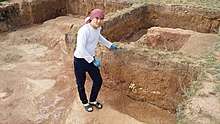Botai culture

The Botai culture is an archaeological culture (c. 3700–3100 BC)[1] of prehistoric Kazakhstan and North Asia. It was named after the settlement of Botai in Akmola Region of Kazakhstan. The Botai culture has two other large sites: Krasnyi Yar, and Vasilkovka.
David W. Anthony connects the Botai culture to the eastward migration of peoples from the Volga-Ural steppe in the mid-4th millennium BC, which would lead to the establishment of the Afanasevo culture in South Siberia.[2]
The site of Botai is located on the Iman-Burluk River, a tributary of the Ishim River. The site has at least 153 pithouses. The settlement was partly destroyed by river erosion which is still occurring and by management of the wooded area.
The occupations of the Botai people were connected to their horses. Some researchers state that horses were domesticated locally by the Botai.[3] It was once thought that most of the horses in evidence were probably the wild species, Equus ferus, hunted with bows, arrows and harpoons. However, evidence reported in 2009 for pottery containing mare's milk and of horse bones with telltale signs of being bred after domestication have demonstrated a much stronger case for the Botai culture as a major user of domestic horses by about 3,500 BC, close to 1,000 years earlier than the previous scientific consensus. Unexpectedly, Botai horses were the ancestors not of modern domestic horses, but rather of modern Przewalski's horses. Thus, in contrast to current thinking on horse domestication, modern horses may have been domesticated in other, more Western, centers of origin.[4].
The pottery of the culture had simple shapes, most examples being gray in color and unglazed. The decorations are geometric, including hatched triangles and rhombs as well as step motifs. Punctates and circles were also used as decorative motifs.[5]
Asko Parpola believes that the language of the Botai culture cannot be conclusively identified with any known language or language family. He speculatively suggests that the Proto-Ugric word *lox for "horse",[6] (reconstructed on the basis of Hungarian ló, Mansi lū and Khanty law, all meaning "horse"), whose origin is unclear and which does not closely resemble any of the words for "horse" from known Eurasian language families, is a borrowing from the language of the Botai culture, a word which is neither of Uralic nor Indo-European origin.[7]
Current research is being conducted by Alan Outram of Exeter University in association with other institutes, the Bristol (UK), Winchester (UK), and Kokshetau (Kazakhstan) universities, and the Carnegie Museum. Along with students, Outram conducted a magnetometer survey of the Botai site in 2008, and is looking into conducting further research into the Botai culture's role into the development of horse domestication.[3]
References
- ↑ Mair, Victor H.; Hickman, Jane (8 September 2014). Reconfiguring the Silk Road: New Research on East-West Exchange in Antiquity. University of Pennsylvania Press. p. 15. ISBN 1934536695. Retrieved 13 June 2015.
- ↑ Anthony, David W. (26 July 2010). The Horse, the Wheel, and Language: How Bronze-Age Riders from the Eurasian Steppes Shaped the Modern World. Princeton University Press. pp. 264–265. ISBN 1400831105. Retrieved 13 June 2015.
- 1 2 Outram, Alan K.; et al. (6 March 2009), "The Earliest Horse Harnessing and Milking", Science, 323: 1332–1335, doi:10.1126/science.1168594, PMID 19265018, retrieved 2010-12-27
- ↑ Gaunitz C, Fages A, Hanghøj K, Albrechtsen A, Khan N, Schubert M, et al Ancient genomes revisit the ancestry of domestic and Przewalski’s horses. Science. 2018 Apr 6;360(6384):111–4.
- ↑ "Carnegie Museum of Natural History: Sandra Olsen". Carnegiemnh.org. Archived from the original on 2012-01-28. Retrieved 2012-09-27.
- ↑ See also Uralic Etymological Database
- ↑ Parpola, Asko (2012). "The problem of Samoyed origins in the light of archaeology: On the formation and dispersal of East Uralic (Proto-Ugro-Samoyed)" (PDF). In Hyytiäinen, Tiina; Jalava, Lotta; Saarikivi, Janne; Sandman, Erika. Per Urales ad Orientem. Iter polyphonicum multilingue. Festskrift tillägnad Juha Janhunen på hans sextioårsdag den 12 februari 2012. Mémoires de la Société Finno-Ougrienne 264. Helsinki: Finno-Ugrian Society. pp. 295f. ISBN 978-952-5667-33-2. Retrieved 25 January 2015.